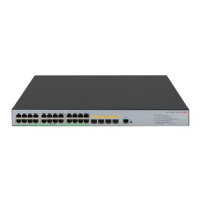258
IMPORTANT:
• To configure an MBGP peer group, you must enable the correspondin
IPv4 BGP unicast peer
roup in
IPv4 MBGP address family view.
• Before adding an MBGP peer to an MBGP peer group, you must add the corresponding IPv4 unicast
peer to the IPv4 BGP peer group.
To configure an IPv4 MBGP peer group:
Ste
Command
Remarks
1. Enter system view.
system-view N/A
2. Enter BGP view.
bgp as-number N/A
3. Create a BGP peer group.
group group-name [ external |
internal ]
Not created by default.
4. Add a peer into the peer
group.
peer ip-address group group-name
[ as-number as-number ]
No peer is added by default.
5. Enter IPv4 MBGP address
family view.
ipv4-family multicast N/A
6. Enable the IPv4 unicast peer
group.
peer group-name enable N/A
7. Add an IPv4 MBGP peer to
the peer group.
peer ip-address group group-name
Not configured by default.
Configuring MBGP community
The COMMUNITY attribute can be advertised between MBGP peers in different ASs. Routers in the same
community share the same policy.
You can reference a routing policy to modify the COMMUNITY attribute for routes sent to a peer. In
addition, you can define extended community attributes as needed.
When you configure MBGP community, you must reference a routing policy to define the specific
COMMUNITY attributes, and apply the routing policy for route advertisement. For routing policy
configuration, see Layer 3—IP Routing Configuration Guide.
To configure MBGP community:
Ste
Command
Remarks
1. Enter system view.
system-view N/A
2. Enter BGP view.
bgp as-number N/A
3. Enter IPv4 MBGP address
family view.
ipv4-family multicast N/A

